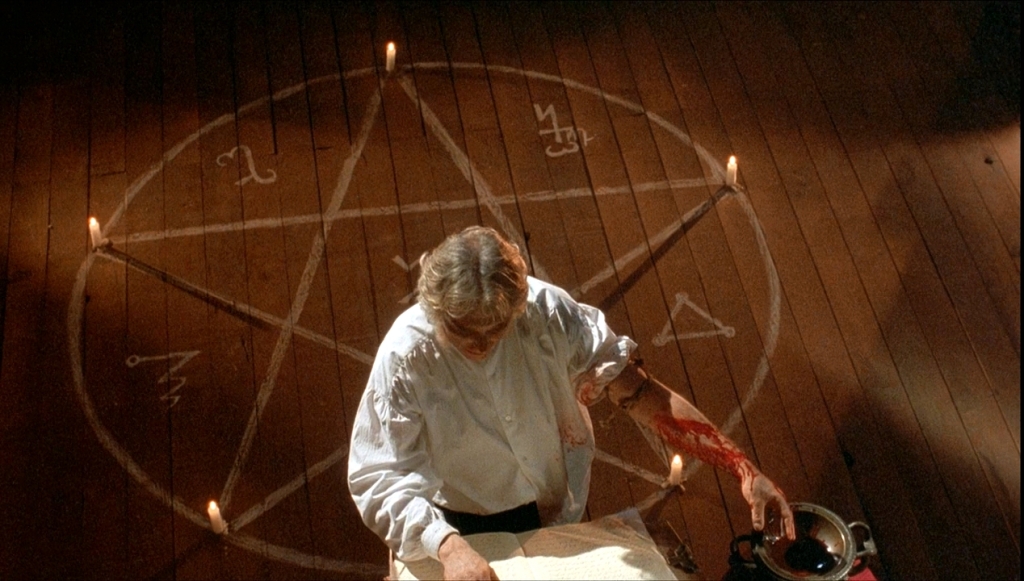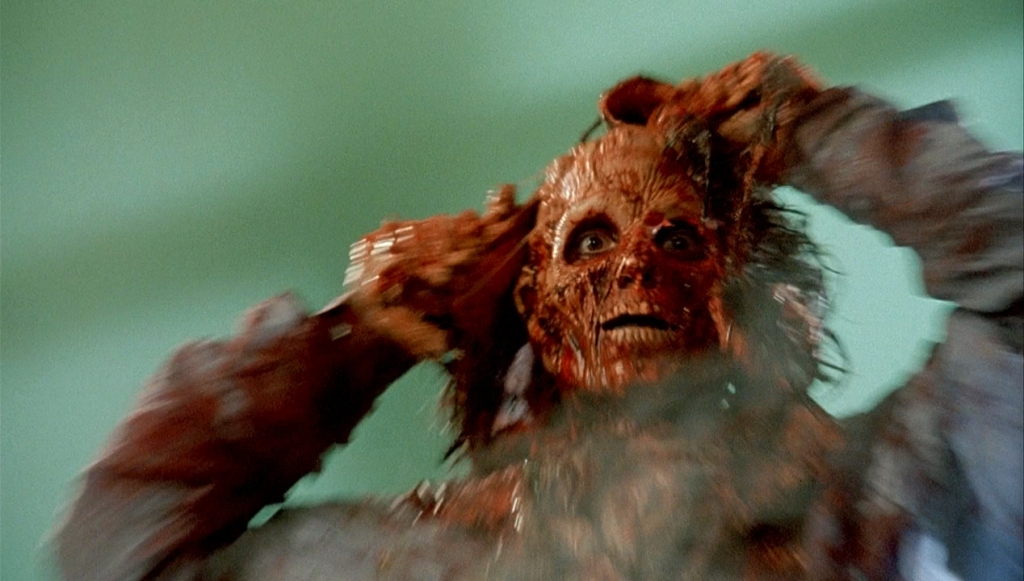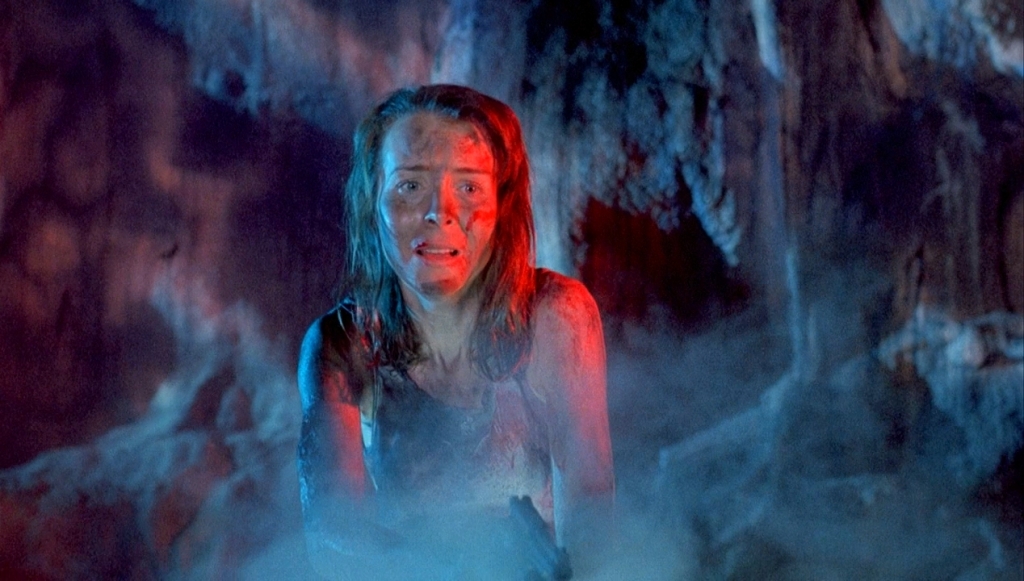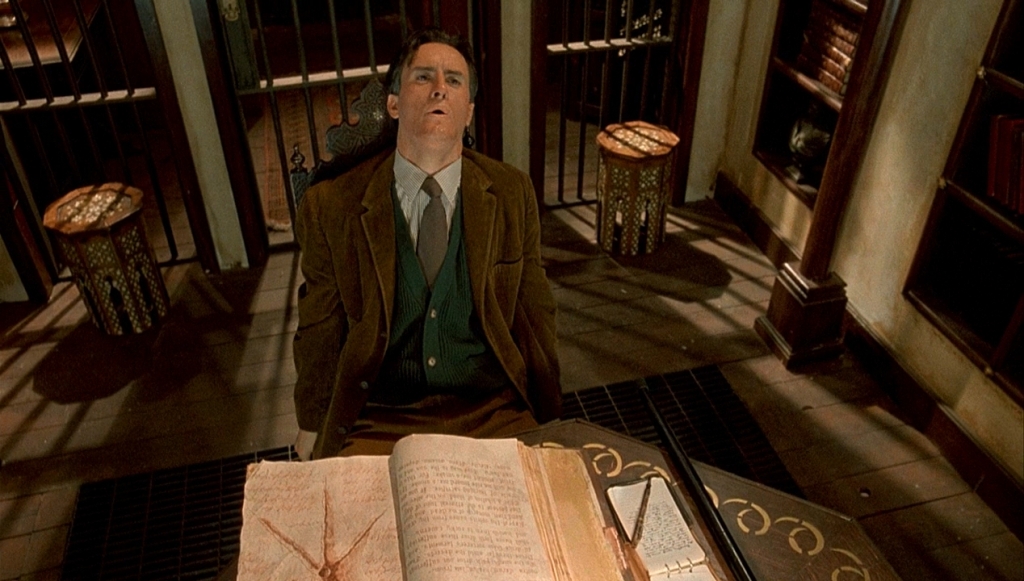Necronomicon is an anthology film based on three H. P. Lovecraft short stories. The kind of film that you’d once see in the video rental store with a lurid cover that promised a trashy but fun evening in. And trashy but fun it is!
It’s the progeny of Brian Yuzna. Yuzna is probably best known as the director of Society (1989), a body-horror satire about the American upper classes (a theme also recently explored in the excellent Ready or Not). His directorial debut, the last ten minutes of Society morphed into a gooey orgy of over-the-top, gruesome practical effects. It was a phenomenal calling card.
However, before making Society, Yuzna was (and continues to be) a film producer and his projects include From Beyond, cult hit Reanimator and its sequel Bride of Reanimator, all Lovecraft adaptations. He also produced Honey, I Shrunk The Kids.

Necronomicon, released four years after Society, was originally intended to be a low-budget straight-to-video release that would give Yuzna enough freedom to faithfully realise the essence of his beloved Lovecraft. The film had been a project for Yuzna’s for years.
However somehow international funding came rolling in and they ended up with a budget much greater than they had originally anticipated; if only all independent films had the same problem! The filmmakers now could afford some lavish sets and special effects, although the extra responsibilities had some drawbacks. According to writer Brent V. Friedman, who was originally brought in to make the first draft scarier, the project evolved from a straightforward horror film to something a bit artier: “all the boundaries got completely expanded when more money came in – for better and for worse”. And Yuzna conceded that eventually the film became only “loosely based on Lovecraft”.
The film consists of:
- a non-Lovecraft wraparound, The Library, which sees the author (played by genre star Jeffrey Combs) sneaking into a forbidden vault to transcribe these stories from a secret book called the ‘Necronomicon’.
- The Drowned based on The Rats in the Walls and directed by Christophe Gans,
- The Cold based on Cool Air, directed by Shusuke Kaneko, and
- Whispers based on The Whisperer in Darkness. Yuzna directed that final tale and also the wraparound story in the library.
Necronomicon is a lot of fun and its 93 minutes race by. However, like most anthology films, the quality of the individual segments varies wildly.
The Drowned
For me, the least successful is the first story based on The Rats in the Walls, although curiously some people consider this the best. It’s a gothic-styled monster yarn about a man who inherits a creaking old house in New England and discovers that his ancestor had invoked a curse. His late uncle’s wife and son had died in tragic circumstances and the uncle had reanimated them using an occult incantation. However, the revived duo came back in the form of grotesque tentacled monsters.

This was director Gans’s first film and it shows. The segment lacks a storytelling coherence and the action sequences and narrative are confusing. This isn’t helped by an unwieldy structure which involves both a tale-within-a-tale (the protagonist Edward De LaPoer reading the uncle’s confessions from the past) and also a flashback to Edward’s own personal tragic history, this time shown in black-and-white. Given that the anthology film itself has a tale-within-a-tale structure, the end result is confusing and Gans’s direction struggles. It lacks visual signposts, and individual scenes and motives are bewilderingly unclear – why does Edward leap onto a chandelier above a ravenous octopus monster rather than just run out the door?!
The main character Edward is played Bruce Payne who channels Evil Dead style Bruce Campbell. The lavish gothic sets in an old building look great and evoke Roger Corman’s 1960s Poe films (of which The Haunted Palace is itself based on a Lovecraft story). However, this segment tries to pack in far too much into its brief running time at the sacrifice of atmosphere or excitement.
The Cold
The second tale is more successful, although a bit inconsistent. The initial set-up – an investigative journalist interviewing a landlady in connection to a series of murders – features some of the worst acting I have ever seen. Thankfully, once we get into the story proper things pick up significantly. The source text for this segment is only a few pages long. It concerns a lodger at a boarding house whose upstairs elderly neighbour keeps his rooms exceptionally cold because he has an unusual health condition. When his ammonia-based air conditioning unit breaks down there’s a frantic but fruitless search for a spare part, but too late! The temperature rises and the old man melts into a mere puddle!
The film segment embellishes on this concept significantly. It’s another tale-within-a-tale, although far more coherent than the first episode. The lodger becomes a young woman, Emily, who is hiding from her stepfather. The older man upstairs, Dr Madden, is a mad-scientist and needs a constant supply of corpses to maintain his eternal life (it’s not really explained, but its slightly vampiric). Madden is played by David Warner who had a memorable role as Evil in Terry Gilliam’s Time Bandits. The pair start a relationship and adding to the frenzy is Madden’s envious and murderous assistant Lena (played by Millie Perkins who starred in the 1976 indie horror classic The Witch Who Came In From the Sea).

Made by Japanese director Shusuke Kaneko, who apparently couldn’t speak English (!), the narrative goes in all manner of strange directions. The stepfather subplot feels like something from a lurid 1970s exploitation movie. After the camera surveys her naked but bruised body in the shower, we learn that Emily is fleeing him because he has been sexually abusing her. There’s an uncomfortable scene when she encounters him in her room – “I just came by to watch you practice your flute playing, and now you’re gonna practice on my instrument” – and this jars tonally with the rest of the film. Emily’s later affair with Dr Madden also seems uncomfortable and improbable partly because of the age difference, although it seems entirely consensual.
Despite these tonal incongruities, it’s a surprisingly coherent and enjoyable tale. There’s lots of satisfying twists and threats and I could never quite tell what direction it was going to follow. Of course, the film retains the story’s conclusion, and Dr Madden’s melting scene is satisfyingly grotesque and extended; rather than just melt into a puddle, his body seems to disassemble itself before our eyes.

Indeed, the special effects in Necronomicon are exceptional throughout. Designed by the legendary Tom Savini (Dawn of the Dead, Day of the Dead, Friday the 13th, The Burning and many more), they are lavish and horrific. They are entirely practical effects – this was made just before the dawn of CGI – and they hold up exceptionally well: gloopy, gooey and imaginatively repulsive. If anything, the sheer quality of the effects is what makes this film stand out.
Whispers
The final story, directed by Yuzna, is the best although its unpromising beginning resembles the worst cop movie ever made. Police patrol officers Sarah (Signy Coleman) and Paul (Obba Babatundé) are investigating a serial killer known as ‘The Butcher’. After crashing during a car chase in a dark alley, someone drags Paul’s unconscious body into a nearby building. Sarah, who is carrying Paul’s baby, pursues them into a seemingly-abandoned basement. There she discovers a Mr and Mrs Benedict (Don Calfa of Weekend at Bernie’s fame and Judith Drake who could easily have been an inspiration for the League of Gentlemen’s Tubbs). Bordering between comedic and threatening, the pair lead Sarah through a labyrinthine pursuit that involves pink bat-like crab monsters straight out of Lovecraft’s original story.

This segment is genuinely nuts and very entertaining for it. Instead of the narrative confusion of the first part, this final episode deliberately and constantly confuses you so you never really know what’s going on. Is Benedict ‘The Butcher’? Is he alien? What is their relationship? Are they also crab monsters? Why are there crab monsters living the basement anyway? The pacing is relentless and the twists and turns are engaging.
It’s difficult to describe this, and because the whole thing is just so weird and entertaining its best just to experience it. The effects are very effective; they’re continually piled on – Paul’s fate is particularly satisfying – and they help emphasise a final reveal that is conceptually genuinely unnerving. The direction is fun, you are pulled into the story and the whole thing is a thrill ride.
The pregnancy theme introduced at the start is revisited in a thread about creating and sustaining life (which perhaps coincidentally is also touched upon in the second segment). The freakish crab monsters are straight out of Lovecraft lore – he seemed to have a fear of monsters that resembled seafood, and some of the practical body-horror is exceptional.

The Library
After the thrills of Whispers, the concluding wraparound story slackens off the pace a little, but The Library is a fun and campy tale about the author’s attempt to steal the Necronomicon book from its creepy custodians, narrowly avoiding a terrible fate. Also directed by Yuzna, there are some nice set-pieces – I particularly liked one of the monks squeezing through some narrow bars – and its rapid pace and adventure theme is a nice conclusion to the film.

In Conclusion
For a portmanteau film that should have been a mess given its production history, Necronomicon is surprisingly successful. Tom Savini’s special effects are a highlight, and the film’s pacing and inventiveness ensure it’s never dull. If anything, it tries to cram too much into its relatively brief run-time.
It’s scrappy, and some of the directing, dialogue and acting is terrible rather than terrifying, but that doesn’t seem to matter much as the film moves briskly and never takes itself too seriously.
Despite its original ambitions, it isn’t particularly faithful to Lovecraft. A few elements here and there, some plot points, some characters, but it misses the author’s sense of uncanny horror despite the monsters capturing some of his aquatic terrors. Lovecraft has proven difficult to translate to film, although perhaps Richard Stanley’s imminent Color Out of Space will be more successful.
Despite its flaws Necronomicon is very enjoyable and it’s a shame that the film appears to have all but vanished. Although far from being a classic, it’s definitely due a reappraisal.
Quotations are from an article in Fangoria issue 135, August 1994, reproduced by the BFI.
Follow @davefilmblog